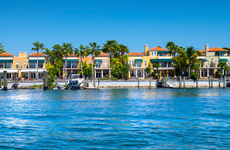The best and worst states to retire in 2023, ranked

The Bankrate promise
At Bankrate we strive to help you make smarter financial decisions. While we adhere to strict , this post may contain references to products from our partners. Here's an explanation for .
To move or not to move when you retire? That’s the big question.
Picking a place to retire is one of life’s most consequential decisions — and ultimately, a deeply personal choice. You may want to settle down by the beach or in the mountains. Maybe you prefer golf over cross-country skiing, or you just want to be near your kids or grandkids. With all these possibilities in front of you, you may not know where to start.
To find some objective answers to the where-to-retire question, Bankrate crunched a bevy of statistics on costs of living, public health and other metrics to create a comprehensive ranking of the best and worst states to retire in the U.S. We analyzed five broad categories across all 50 states: affordability, overall well-being, the cost and quality of healthcare, weather and crime.
The category that we weighed the heaviest was affordability, to reflect the challenges that so many Americans face in today’s economy. The housing market remains competitive, with high borrowing costs, expensive housing prices and low inventory. At the same time, inflation has rocked Americans’ wallets over the last two years, leaving many feeling behind on their retirement and looking for ways to stretch their savings.
It’s important to note our ranking is simply a starting point for making a decision. If you own a paid-off home in a high-cost area like Boston or Los Angeles, maybe affordability isn’t your priority. And, of course, not everyone likes the sweltering summers of the Sun Belt states.
Don’t rule out places that seem unlikely. It’s important for people to get excited about that next chapter of life. It’s a new adventure, and you should really take the time to do the prep work financially and personally so that you make smart decisions.
— Kerry HannonRetirement Expert and Author of ‘In Control at 50+: How to Succeed in the New World of Work’
Key takeaways
- The best state to retire is Iowa because of its lower cost of living, affordable but high-quality healthcare and low crime. Delaware, West Virginia, Missouri and Mississippi round out the top five.
- The best and worst states for retirees are split geographically. The Midwest and the South claim the top five states, while the Northeast and West claim the bottom five states, primarily because of the difference in cost of living.
Best and worst states to retire in 2023
The common narrative is that retirees leave colder or high-cost states such as New York, New Jersey and California for traditional retirement destinations with warm weather, a relatively low cost of living and other perks for seniors. And while that continues to be the case in 2023, experts say older Americans shouldn’t rule out places that aren’t traditionally top of mind for retirement.
Bankrate’s latest study found that Iowa is the best state for retirement, followed by Delaware, West Virginia, Missouri and Mississippi. Alaska, on the other hand, held last place in our ranking. The state was dragged down by back-of-the-pack scores in affordability and weather. In addition to Alaska, the remaining four worst states for retirement were New York, California, Washington and Massachusetts.
| 5 best states to retire | 5 worst states to retire |
|---|---|
| 1. Iowa | 50. Alaska |
| 2. Delaware | 49. New York |
| 3. West Virginia | 48. California |
| 4. Missouri | 47. Washington |
| 5. Mississippi | 46. Massachusetts |
Why Iowa is the best state to retire
You may be wondering: Why Iowa? With its vast farmlands, peaceful countryside and friendly locals, Iowa offers a unique retirement experience for many Americans seeking a more relaxed and affordable lifestyle with access to the outdoors and retirement-age communities.
Iowa’s affordability is a big draw for retirees. Iowa is the sixth cheapest place to live in the U.S., according to the Council for Community and Economic Research, which is an advantage for retirees on a fixed income. Lower housing costs also helped prop the Hawkeye state up to the No. 3 spot for affordability. Iowa’s median home price is $239,400, per Redfin data — well below the nationwide median home price of $388,800. Homeowners insurance in Iowa is also below the national average.
Iowa lands near the middle of the pack tax-wise. The state ranks No. 23 for property taxes and No. 22 for state and local sales tax. Iowa also doesn’t tax Social Security benefits, and Iowans age 55 and older are exempt from paying state taxes on retirement income for tax year 2023. The state also topped our ranking for its high-quality healthcare services and low healthcare costs.
If you’re looking for retirement-age friends, you’ll have a good chance of finding them in this state as well, where nearly 20 percent of the population is age 65 and older, Census data shows.
Meanwhile, for potential retirees seeking a cultural melting pot and warm weather, Iowa may not be a good choice. It ranks poorly for racial and ethnic diversity, and its community-well being index is subpar. It also is generally colder in Iowa and has a high incidence of tornadoes, which may not be appealing for many retirees.
But it’s not just Iowa at the top of the list. The rest within the top five are:
- Delaware: For retirees considering a move to Delaware, well-being is a big selling point. The state combines high-quality healthcare and a light tax burden to rank No. 2 overall. Diversity, wellness and culture are other strong points. The state ranks near the top for racial and ethnic diversity, arts and entertainment establishments per capita and wellness. It also has one of the nation’s highest percentages of over-65 residents. Earthquakes, tornados and hurricanes are rare — and it places in the middle of the pack in our rankings for both cost of healthcare and crime. The state’s only weaker spot is in the affordability category — this East Coast state ranks No. 31 for cost of living.
- West Virginia: This small state boasts the best affordability in the nation, based on a low cost of living and light tax burden. The state fell in the middle of the pack for wellness, placing No. 26 in that category.
- Missouri: Fourth-place Missouri shines for affordability, but struggles with its quality of healthcare, crime and natural disasters.
- Mississippi: Another Sun Belt surprise, Mississippi scored well on affordability, weather and crime but suffered in two other key categories, healthcare and overall well-being.
Relocating in retirement can stretch your savings in today’s economy
While many people ponder a late-life move, most American retirees actually age in place.
A Census Bureau report last year found that from 2015 to 2019, only about 6.2 percent of the population over age 65 had moved in a given year, compared to about 15 percent of younger people. Still, older adults are increasingly relocating to meet their changing needs and preferences.
Analysis from the American Planning Association found more senior movers tended to be renters, those with lower incomes, those with higher housing cost burdens, and those who live alone. Three of the most common reasons that older adults move were living closer to family members, living in better neighborhoods and reducing housing costs, according to the analysis.
Family and weather are the main reasons Karen B, a 64-year-old escrow mortgage officer based in Southern California, doesn’t plan on moving as she transitions into retirement — despite its high living costs. In Bankrate’s study, California ranked at the bottom (48) for retirement.
“I’ve lived in Southern California now for a long time, and with those two things, I really don’t plan to move,” she says. “The only thing would be the taxes of my state.”
Unlike most Americans, Karen said she feels comfortable with their retirement savings and cutting costs where needed. She has been aggressively saving for retirement over the last two decades and did everything she could to max out her 401(k) every year after realizing her 401(k) balance was under $10,000 in 2000.
“I would live on less,” she said. “I wouldn’t have cable. I had friends tell me that I had become the master of saving. There was no instant gratification, and I encouraged friends and family to do the same.”
But the reality is that most Americans don’t feel confident about their retirement savings. A Bankrate survey in October found more than half of working Americans (55 percent) say their retirement savings are not where they need to be, with nearly 35 percent saying they’re significantly behind. That percentage goes up with age, according to the survey.
With states in the Midwest and South viewed as more affordable, experts say retirees looking to stretch their retirement income may want to consider them over the higher cost of living in the Northeast and West.
One perk of relocating to an area where the real estate market is more affordable and less competitive, is taking advantage of the equity built up in the home that’s left behind and paying cash for a new home, Hannon says.
“If you can do so, maybe you can sell your home where you live right now and move to an area of the country that’s less expensive, and not have to have a mortgage,” she said.
If you’re considering relocating, Hannon also suggests looking for towns or cities with more reasonable healthcare costs because it’s a sizable cost cutter for retirees.
“Don’t move necessarily for the sunshine, but maybe for the healthcare costs,” she said.
Personal finance expert Shang Saavedra says to know where you’re going, you need to know where you’re at with your retirement savings. Saavedra recommends starting with a retirement calculator to see if you’re on track. If you’re not on track, calculate how much more you need to reach your goal and start putting together a plan.
“Determining how much you have available for retirement then leads to all the other decisions for your lifestyle,” she said. “Once you know that, look at your expenses today and ask yourself: ‘Can I afford that?’ If not, then the biggest impact would be determining where to live.”
3 expert tips for retirement planning
Considering a retirement move? Here’s advice from experts who help retirees and soon-to-be-retired workers through the decision:
1. Take current and future costs to relocate into account
If you’re going to uproot and relocate to another area, you have to make a decision not only about the way things look today, but whether a place is going to be sustainable and less expensive over the long term. You have to look at the full picture.
— Larry SprungFinancial Advisor and Founder of Mitlin Financial
2. Consider a trial run in a new place
Consider renting a place for six months to ensure you have a community there. See if it’s easy to join groups, whether it’s joining a bowling league or a volunteer organization. Set up your community before you take that leap.
— Kerry HannonRetirement Expert and Author of ‘In Control at 50+: How to Succeed in the New World of Work’
3. Saving on housing costs isn’t the whole story
Making a decision about your housing can impact your bottom line, but it’s also important to think about how your home works for you. None out of 10 of those 65 and older say that they want to stay in their home or community as they age, but the home can cause challenges for that. Think about your needs now and into the future, and know that your needs might change. How does your home work for yourself today and your future self?
— Rodney HarrellVice President of Family, Home and Community at AARP’s Public Policy Institute
How your state ranks for retirement
-
Bankrate looked at several public and private datasets related to the life of a retiree. The study examined five categories (weightings in parentheses): affordability (40 percent), overall well-being (25 percent), quality and cost of healthcare (20 percent), weather (10 percent) and crime (5 percent).
Affordability was calculated using the following: the 2023 cost of living index from the Council for Community and Economic Research; state property and sales tax rates from the Tax Foundation’s rankings for 2023 and cost of homeowner’s insurance by state from ATTOM Data Solutions.
For wellness rankings, Bankrate analyzed 2020 and 2021 data from the U.S. Census Bureau, including number of arts, entertainment and recreation establishments per capita, adults 65 and older per capita and the racial and ethnic diversity index. Bankrate also used the Sharecare Community Well-Being Index released in 2021. The index measures various factors, including access to healthcare, food, physical health and economic security.
To measure healthcare quality and costs across all 50 states, Bankrate considered healthcare establishments per capita for 2021 from the U.S. Census Bureau, state health system performance and cost of healthcare per capita. Cost of healthcare per capita is the average cost per person to different payers for various healthcare services, both private and public, in that state from the Centers for Medicare and Medicaid Services Office of the Actuary. State health system performance was based on 2022 data from The Commonwealth Fund, a private foundation dedicated to affordable, quality healthcare for all.For weather scores, we relied on decades of average annual temperature data from the National Oceanic and Atmospheric Administration. Bankrate also analyzed NOAA data for tornado strikes and hurricane landfalls, along with earthquake reports from the U.S. Geological Survey.
We calculated crime using the rates of property crimes and violent crimes per 100,000 inhabitants for each state from the FBI’s 2019 Crime in the United States report. (Because the FBI significantly changed the reporting format for 2020 data, we did not rely on those statistics.)
Related Articles

Iowa is the best state to retire: Here’s why it won Bankrate’s top honors



One of the least populated states should be America’s hottest retirement destination — here’s why